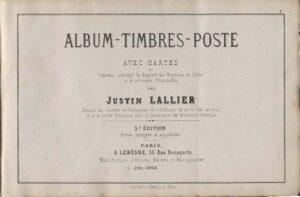

It is this spirit that old stamp albums are among our most important philatelic records. Stamp albums were created for a reason— to put stamps in. And proof that they corresponded to a real collector need— in other words, that they are an accurate record of what many collectors were trying to accomplish in the period for which the albums were sold— was truly market tested. Albums that didn’t meet collector needs didn’t sell, and we don’t have many that have come down to us. Alternatively, albums that sold well over a long period of time show us that they filled collector needs and show us what most of the collectors in a given time period were trying to do.
Justin Lallier was the first stamp album producer, and here is one of his earliest stamp albums, printed in 1862, just a bit more than twenty years after the first postage stamp. The album is about 150 pages, showing that even by just twenty years into stamp issuance there was already a very wide body of material to collect. The album has spaces for all the stamps issued to that time and is not illustrated (anti-counterfeiting enforcement at the time was spotting and arbitrary, and it was not really until the early twentieth century that most album and catalog producers felt comfortable illustrating most stamps). There are spaces for envelope stamps, and already the album makers were identifying special service stamps and locals. The album has very narrow spaces for the perforated stamps showing that collectors were expected to trim their stamps to fit the album and that perforated stamps often had their perforations clipped off. The stamps are glued into the album, and if the stamps are to be removed the album must be destroyed and the stamps soaked off. Mint stamps then will no longer have gum.
And look at the quality of the stamps that the collectors thought acceptable to collect! Philatelists now get upset with anything less than perfect mint NH stamps. This collector of 150 years ago trimmed his stamps, glued his stamps, and collected stamps that could really be called large pieces rather than defective entire stamps. Lallier’s albums were among the most popular in the world and were produced in various editions throughout the nineteenth century. They only stopped being produced when enough stamps had been produced by most countries to make specialty country collecting popular, and these albums were replaced in France by the Yvert country specialty series.
The evolution of collector tastes shows clearly in this 150 year old document. We used to collect the world; we now collect largely by country. We used to collect mint and used indiscriminately; most collectors now collect one or the other, and we used to care very little for quality. Philately as it is practiced today has a long past. It has evolved and is continuing to do so even now. The point of knowing where the hobby has been is to help us better guess where it is going.
